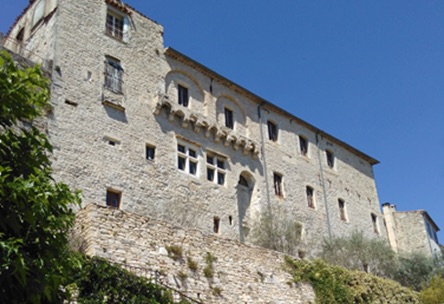An ideal place for a future family assembly
Where is Vézénovres located?

A village where the GINOUX des Cévennes owned land in 1377!

Dominated by the ruins of its castle, the village of Vézénobres clings to the heights of a cliff, an obligatory passage for crusaders leaving for the holy land and for the pilgrims of Saint-Gilles. Labeled “Village of Character”, it offers an exceptional panorama of the garrigue and the Cévennes.
The medieval city contains many testimonies of the importance of Vézénobres as a strategic crossroads on the Piedmont des Cévennes, 10km from Alès, on the border of Provence and the Mediterranean coast.
The Hotel de Montfaucon, known as the “House of Adam and Eve”.
The facades are characteristic of various periods. The most sumptuous of them is that of the Hôtel de Montfaucon, known as the “House of Adam and Eve”. From the Renaissance period, the construction of this mansion was decided in 1547 by the Baroness Françoise de Montfaucon. The façade also has beautiful mullioned windows and a very elegant polygonal tower topped by a terrace. The pediment decorated with foliage and daisies is framed on the right by two Italian-inspired figures representing Prudence and Strength.
The parish church of Saint Andrew
St. Andrew’s Church was rebuilt after the Wars of Religion in the lower part of the village. Its apse is decorated with a superb 18th century mural, restored.
One reaches the upper part by crossing the Sabran gate (early 13th century), also called the Clock Tower, the only vestige of the medieval enclosure.
The city developed along three parallel streets linked by endrounes – narrow and steep passages – which give it a medieval charm.
The street of the Romanesque houses
Vézénobres has preserved an architectural heritage of the XII and XIII centuries that can be admired in the rue des Maisons Romanes. They probably belonged to merchants from Pisa or Genoa who would have established a trading post on this commercial axis between the Massif Central and the Mediterranean.
The house in calaberts (dried figs)
On the heights of the village, in the direction of the Castle of Montanègre, of which only ruins remain, you will see the house in “calaberts”. For many centuries, Vézénobres was specialized in figs, which were dried under the “calaberts”, terraces sheltered from the houses where they stored racks for drying the fruit. They were sold in autumn during the Saint-André Fair.

The castle of Girard
Built by the de Girard family in the 14th century, the castle was integrated into the fortifications.
It was ceded to the commune by the Marquis of Thoiras in the 17th century and houses the Town Hall and the Tourist Office, where a team of enthusiasts will be able to answer all your queries.
On the south side the haughty facade of the castle dominates the fig tree orchard, a thousand trees representing more than 100 varieties planted under the aegis of the National Conservatory of Porquerolles.
Every year, Vézénobres revives the tradition and welcomes the Figoulade, a market of fresh figs on the 3rd Sunday of August and the Mediterranean Days of the Fig on the last weekend of October.
Vézénobres was famous for its production of dried figs. These were sold in autumn during the Saint-André fair. Recent efforts have made it possible to revive this tradition since the village is now home to the fig tree orchard-conservatory: a thousand trees representing more than 100 different varieties were planted in 2000, 2004 and 2006 under the aegis of the National Botanical Conservatory located on the island of Porquerolles.
This fig crop is celebrated every year during the Mediterranean Fig Days which take place at the end of October. These place Vézénobres at the center of a Euro-Mediterranean network focused on biodiversity and sustainable development.
The orientation table: a superb panorama
Going through the rue de la Porte du Fort, at the end of the rue du Haut-Plan, a staircase leads to the orientation table and the breathtaking panorama rewards all the efforts made to get up there.
Vézénobres is the ideal starting point to visit the Cévennes and less than half an hour away Alès, Anduze, the Grotte de Trabuc, but also Uzès at 27 km and Nîmes at 35 km.

